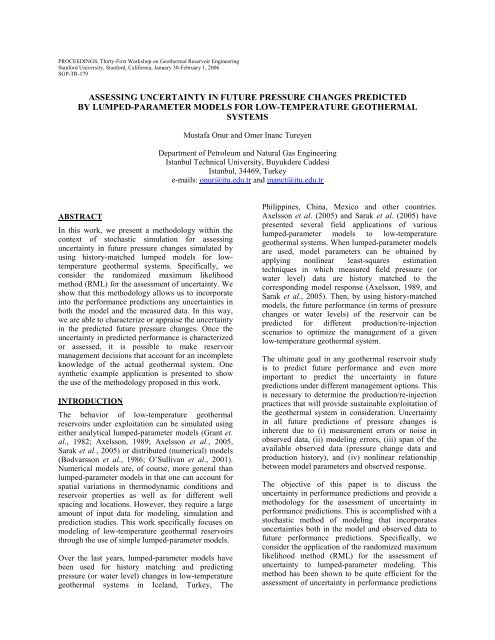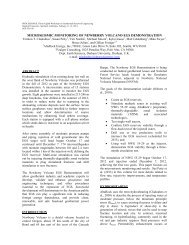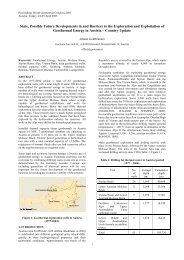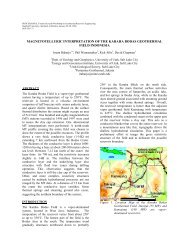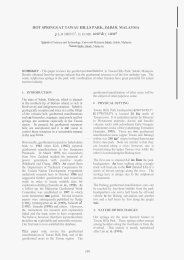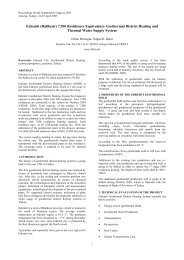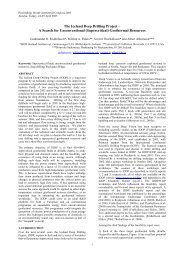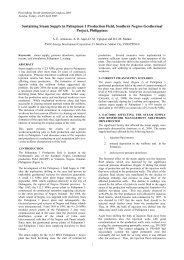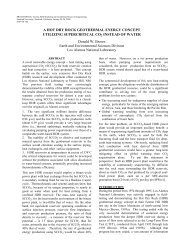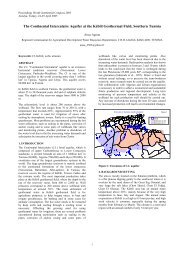Assessing Uncertainty in Future Pressure Changes Predicted By ...
Assessing Uncertainty in Future Pressure Changes Predicted By ...
Assessing Uncertainty in Future Pressure Changes Predicted By ...
Create successful ePaper yourself
Turn your PDF publications into a flip-book with our unique Google optimized e-Paper software.
PROCEEDINGS, Thirty-First Workshop on Geothermal Reservoir Eng<strong>in</strong>eer<strong>in</strong>g<br />
Stanford University, Stanford, California, January 30-February 1, 2006<br />
SGP-TR-179<br />
ASSESSING UNCERTAINTY IN FUTURE PRESSURE CHANGES PREDICTED<br />
BY LUMPED-PARAMETER MODELS FOR LOW-TEMPERATURE GEOTHERMAL<br />
SYSTEMS<br />
ABSTRACT<br />
In this work, we present a methodology with<strong>in</strong> the<br />
context of stochastic simulation for assess<strong>in</strong>g<br />
uncerta<strong>in</strong>ty <strong>in</strong> future pressure changes simulated by<br />
us<strong>in</strong>g history-matched lumped models for lowtemperature<br />
geothermal systems. Specifically, we<br />
consider the randomized maximum likelihood<br />
method (RML) for the assessment of uncerta<strong>in</strong>ty. We<br />
show that this methodology allows us to <strong>in</strong>corporate<br />
<strong>in</strong>to the performance predictions any uncerta<strong>in</strong>ties <strong>in</strong><br />
both the model and the measured data. In this way,<br />
we are able to characterize or appraise the uncerta<strong>in</strong>ty<br />
<strong>in</strong> the predicted future pressure changes. Once the<br />
uncerta<strong>in</strong>ty <strong>in</strong> predicted performance is characterized<br />
or assessed, it is possible to make reservoir<br />
management decisions that account for an <strong>in</strong>complete<br />
knowledge of the actual geothermal system. One<br />
synthetic example application is presented to show<br />
the use of the methodology proposed <strong>in</strong> this work.<br />
INTRODUCTION<br />
The behavior of low-temperature geothermal<br />
reservoirs under exploitation can be simulated us<strong>in</strong>g<br />
either analytical lumped-parameter models (Grant et.<br />
al., 1982; Axelsson, 1989; Axelsson et al., 2005,<br />
Sarak et al., 2005) or distributed (numerical) models<br />
(Bodvarsson et al., 1986; O’Sullivan et al., 2001).<br />
Numerical models are, of course, more general than<br />
lumped-parameter models <strong>in</strong> that one can account for<br />
spatial variations <strong>in</strong> thermodynamic conditions and<br />
reservoir properties as well as for different well<br />
spac<strong>in</strong>g and locations. However, they require a large<br />
amount of <strong>in</strong>put data for model<strong>in</strong>g, simulation and<br />
prediction studies. This work specifically focuses on<br />
model<strong>in</strong>g of low-temperature geothermal reservoirs<br />
through the use of simple lumped-parameter models.<br />
Over the last years, lumped-parameter models have<br />
been used for history match<strong>in</strong>g and predict<strong>in</strong>g<br />
pressure (or water level) changes <strong>in</strong> low-temperature<br />
geothermal systems <strong>in</strong> Iceland, Turkey, The<br />
Mustafa Onur and Omer Inanc Tureyen<br />
Department of Petroleum and Natural Gas Eng<strong>in</strong>eer<strong>in</strong>g<br />
Istanbul Technical University, Buyukdere Caddesi<br />
Istanbul, 34469, Turkey<br />
e-mails: onur@itu.edu.tr and <strong>in</strong>anct@itu.edu.tr<br />
Philipp<strong>in</strong>es, Ch<strong>in</strong>a, Mexico and other countries.<br />
Axelsson et al. (2005) and Sarak et al. (2005) have<br />
presented several field applications of various<br />
lumped-parameter models to low-temperature<br />
geothermal systems. When lumped-parameter models<br />
are used, model parameters can be obta<strong>in</strong>ed by<br />
apply<strong>in</strong>g nonl<strong>in</strong>ear least-squares estimation<br />
techniques <strong>in</strong> which measured field pressure (or<br />
water level) data are history matched to the<br />
correspond<strong>in</strong>g model response (Axelsson, 1989, and<br />
Sarak et al., 2005). Then, by us<strong>in</strong>g history-matched<br />
models, the future performance (<strong>in</strong> terms of pressure<br />
changes or water levels) of the reservoir can be<br />
predicted for different production/re-<strong>in</strong>jection<br />
scenarios to optimize the management of a given<br />
low-temperature geothermal system.<br />
The ultimate goal <strong>in</strong> any geothermal reservoir study<br />
is to predict future performance and even more<br />
important to predict the uncerta<strong>in</strong>ty <strong>in</strong> future<br />
predictions under different management options. This<br />
is necessary to determ<strong>in</strong>e the production/re-<strong>in</strong>jection<br />
practices that will provide susta<strong>in</strong>able exploitation of<br />
the geothermal system <strong>in</strong> consideration. <strong>Uncerta<strong>in</strong>ty</strong><br />
<strong>in</strong> all future predictions of pressure changes is<br />
<strong>in</strong>herent due to (i) measurement errors or noise <strong>in</strong><br />
observed data, (ii) model<strong>in</strong>g errors, (iii) span of the<br />
available observed data (pressure change data and<br />
production history), and (iv) nonl<strong>in</strong>ear relationship<br />
between model parameters and observed response.<br />
The objective of this paper is to discuss the<br />
uncerta<strong>in</strong>ty <strong>in</strong> performance predictions and provide a<br />
methodology for the assessment of uncerta<strong>in</strong>ty <strong>in</strong><br />
performance predictions. This is accomplished with a<br />
stochastic method of model<strong>in</strong>g that <strong>in</strong>corporates<br />
uncerta<strong>in</strong>ties both <strong>in</strong> the model and observed data to<br />
future performance predictions. Specifically, we<br />
consider the application of the randomized maximum<br />
likelihood method (RML) for the assessment of<br />
uncerta<strong>in</strong>ty to lumped-parameter model<strong>in</strong>g. This<br />
method has been shown to be quite efficient for the<br />
assessment of uncerta<strong>in</strong>ty <strong>in</strong> performance predictions
for nonl<strong>in</strong>ear problems (Kitanidis et al., 1995; Oliver<br />
et al., 1996; Liu and Oliver, 2003; Gao et al., 2005).<br />
The paper beg<strong>in</strong>s with a brief review of lumpedparameter<br />
models considered <strong>in</strong> this study. Then,<br />
history match<strong>in</strong>g and performance prediction<br />
problems with<strong>in</strong> the context of maximum likelihood<br />
and randomized maximum likelihood methods are<br />
discussed. F<strong>in</strong>ally, a synthetic example application is<br />
presented to demonstrate the methodology proposed<br />
<strong>in</strong> this study for the assessment of uncerta<strong>in</strong>ty <strong>in</strong><br />
performance predictions by lumped-models for lowtemperature<br />
geothermal systems.<br />
LUMPED PARAMETER MODELING<br />
The lumped-parameter model<strong>in</strong>g considered here is<br />
very similar <strong>in</strong> concept to the one presented<br />
orig<strong>in</strong>ally by Axelsson (1989) and identical to the<br />
one presented later by Sarak et al. (2003a, 2003b, and<br />
2005). As <strong>in</strong> these works, our lumped-parameter<br />
models are based on the conservation of mass only<br />
and hence are valid for low-temperature liquid<br />
reservoirs under the assumption that variations <strong>in</strong><br />
temperature with<strong>in</strong> the system can be neglected (i.e.<br />
the simulated systems are assumed to be isothermal).<br />
Lumped-parameter model<strong>in</strong>g can be regarded as a<br />
highly simplified form of numerical model<strong>in</strong>g. In<br />
numerical models, a geothermal system is<br />
represented by many (>100 to 10 6 ) gridblocks. On the<br />
other hand, <strong>in</strong> lumped-parameter model<strong>in</strong>g, a<br />
geothermal system is represented by only a few<br />
homogeneous tanks and is visualized as consist<strong>in</strong>g of<br />
ma<strong>in</strong>ly three parts: (1) the central part of the<br />
reservoir; (2) outer parts of the reservoir, and (3) the<br />
recharge source. The first two are treated as series of<br />
homogeneous tanks with average properties. The<br />
recharge (or constant pressure) source can be<br />
connected to the other parts of the reservoir or<br />
directly to the central part of the reservoir and is<br />
treated as a “po<strong>in</strong>t source” that recharges the system.<br />
If there is no connection to the recharge source, the<br />
model would be closed, otherwise would be open.<br />
Two different open lumped-parameter models are<br />
depicted <strong>in</strong> Fig. 1.<br />
Recharge<br />
source (pi)<br />
αo1<br />
Outer part<br />
κo1<br />
αr<br />
Reservoir<br />
κr<br />
Net<br />
production<br />
(a) two-tank open lumped-parameter model<br />
Recharge<br />
source (pi)<br />
Outer part 2<br />
Outer part 1<br />
κo2<br />
κo1<br />
αo2 αr<br />
αo1<br />
Net<br />
production<br />
Reservoir<br />
κr<br />
(b) three-tank open lumped-parameter model<br />
Figure 1. Two different lumped-parameter models.<br />
The model shown <strong>in</strong> Fig. 1(a) represents a two-tank<br />
open lumped model, where the first tank, <strong>in</strong> which<br />
production/<strong>in</strong>jection occurs, represents the <strong>in</strong>nermost<br />
(or central) part of the geothermal system. The<br />
changes <strong>in</strong> pressure <strong>in</strong> this part are monitored and<br />
production/<strong>in</strong>jection rates are recorded. In the second<br />
tank, represent<strong>in</strong>g the outer part of the reservoir that<br />
is connected to the recharge source, there is neither<br />
production nor <strong>in</strong>jection, and it recharges the central<br />
reservoir. Fluid production causes the pressure <strong>in</strong> the<br />
reservoir to decl<strong>in</strong>e, which results <strong>in</strong> water <strong>in</strong>flux<br />
from the outer to the central part of the reservoir. The<br />
recharge source represents the outermost part of the<br />
geothermal system.<br />
When us<strong>in</strong>g the lumped-parameter models considered<br />
<strong>in</strong> this work (Fig. 1), the simulated model (output)<br />
response represents pressure or water level changes<br />
for an observation well for a given net production<br />
history (<strong>in</strong>put). The number of model parameters<br />
<strong>in</strong>creases as the number of tanks or the complexity of<br />
the lumped model <strong>in</strong>creases.<br />
Here and throughout, α represents the recharge<br />
constant between the tanks <strong>in</strong> kg/(bar-s), κ represents<br />
the storage capacity (or coefficient) of a tank <strong>in</strong><br />
kg/bar, and pi represents the <strong>in</strong>itial pressure of the<br />
recharge source <strong>in</strong> bar. The geothermal system is<br />
assumed to be <strong>in</strong> hydrodynamic equilibrium <strong>in</strong>itially;<br />
i.e., the <strong>in</strong>itial pressure, pi, is uniform <strong>in</strong> the system.<br />
In cases for which the <strong>in</strong>itial system pressure (or<br />
<strong>in</strong>itial water level), pi, is known, pi can be elim<strong>in</strong>ated<br />
from the unknown set of model parameter vector.<br />
Further details about the lumped-parameter models<br />
used <strong>in</strong> this study can be found <strong>in</strong> Sarak et al. (2003a,<br />
b, and 2005).<br />
HISTORY-MATCHING PROBLEM<br />
After a period of production from a geothermal<br />
reservoir, and based on the production/<strong>in</strong>jection rate<br />
history given, a lumped-parameter model can be<br />
matched to the observed pressure (or water level)<br />
data to obta<strong>in</strong> the parameters of that particular model.<br />
Here and throughout, obs<br />
y refers to the vector of<br />
measured or observed pressure change data, and<br />
conta<strong>in</strong>s all Nd pressure change measurements that<br />
will be used for estimat<strong>in</strong>g the model parameters by
nonl<strong>in</strong>ear regression. We let CD be the NdxNd<br />
symmetric positive-def<strong>in</strong>ite covariance matrix for<br />
pressure change measurement errors, and assume that<br />
measurement errors for pressure data are Gaussian<br />
with mean zero (vector) and covariance matrix CD<br />
[i.e., N(0, CD)]. N(0, CD) represents a normal<br />
distribution with mean zero and covariance matrix<br />
CD. Throughout, a boldface capital letter denotes a<br />
matrix, while a boldface lower case letter denotes a<br />
column vector.<br />
Lett<strong>in</strong>g e denote the Nd-dimensional vector of errors<br />
for observed data and ( 1, 2,<br />
, ) T<br />
m = m m L mM<br />
denote the<br />
vector of unknown model parameters that are<br />
estimated, it follows that<br />
y = f( m) + e. (1)<br />
obs<br />
Here f refers to the Nd-dimensional vector of<br />
computed pressure-change data from a considered<br />
lumped model, for a given m . M represents the total<br />
number of unknown model parameters.<br />
As noted above, e is N(0, CD). Thus, the likelihood<br />
function for the model conditional to observed data is<br />
given by (Bard, 1974)<br />
1<br />
T<br />
⎧ −1<br />
⎫<br />
L(<br />
myobs ) ∝exp ⎨− [ yobs − fm ( ) ] CD[ yobs − fm ( ) ] ⎬<br />
⎩ 2<br />
⎭<br />
(2)<br />
where the superscripts “T” and “-1” represent<br />
transpose of a vector and <strong>in</strong>verse of a matrix,<br />
respectively. The maximum likelihood estimate of m,<br />
which honors measured pressure data, is obta<strong>in</strong>ed by<br />
maximiz<strong>in</strong>g Eq. 2, or equivalently, m<strong>in</strong>imiz<strong>in</strong>g the<br />
objective function O(m) given by<br />
T<br />
obs D obs<br />
−1<br />
[ ] [ ]<br />
O(<br />
m) = y − f( m) C y − f( m ) . (3)<br />
Eq. 3 is the objective function for the well known<br />
general nonl<strong>in</strong>ear least-squares method, and assumes<br />
that the data error covariance matrix CD is known.<br />
Often we do not have enough <strong>in</strong>formation to<br />
construct the data error covariance matrix CD that<br />
may account correlation between measurement<br />
errors. Hence, the commonly used assumption is that<br />
the Nd × Nd<br />
CD is a diagonal matrix <strong>in</strong> Eq. 3. If data<br />
measurement errors are <strong>in</strong>dependent random<br />
2<br />
variables with mean zero and known variance σ<br />
d, j<br />
for each observed data yobs,j, then CD is a diagonal<br />
2<br />
matrix with diagonal entries equal to σ d, j,<br />
j=1,2,…,Nd. In this case, Eq. 3 reduces to the well<br />
known weighted least-squares objective function:<br />
( m)<br />
Nd<br />
⎡ yobs, j − f ⎤ j<br />
O(<br />
m ) = ∑ ⎢ ⎥ . (4)<br />
j = 1 ⎢⎣ σd,<br />
j ⎥⎦<br />
If we further assume that error variances 2<br />
σ d, jare<br />
2 2<br />
identical, i.e., σ = σ for all j, then Eq. 4 with<br />
d , j d<br />
2 1/( σ d ) deleted def<strong>in</strong>es the objective function for the<br />
un-weighted (ord<strong>in</strong>ary) least-squares procedure.<br />
The lumped-parameter model responses are nonl<strong>in</strong>ear<br />
with respect to the model parameters. Thus, Eq. 3 (or<br />
4) calls for nonl<strong>in</strong>ear m<strong>in</strong>imization techniques. Over<br />
the past, we have found that the gradient based<br />
algorithms such as the Levenberg-Marquardt method<br />
based on a restricted procedure described by Fletcher<br />
(1987) is quite efficient to m<strong>in</strong>imize Eq. 3 or 4.<br />
It is important to note that with<strong>in</strong> the context of<br />
maximum likelihood estimation, the observed data<br />
yobs would represent a s<strong>in</strong>gle realization of the<br />
observed data from a normal distribution with mean<br />
zero and known covariance matrix, CD, and thus the<br />
model vector m is considered as a random variable<br />
because different realizations of yobs would provide<br />
different estimates of m. Thus, when historymatch<strong>in</strong>g<br />
problem is viewed with<strong>in</strong> the context of the<br />
pr<strong>in</strong>ciple of maximum likelihood estimation, one can<br />
attach statistical measures to quantify the quality of a<br />
match as well as the uncerta<strong>in</strong>ty of the model<br />
parameters estimated. The standard statistical<br />
measures used for assess<strong>in</strong>g the quality of a match<br />
and the reliability of estimated parameters are the<br />
root-mean-square error (RMS) and confidence<br />
(usually 95% percent) <strong>in</strong>tervals.<br />
The value of RMS def<strong>in</strong>ed by Eq. 5 shows the quality<br />
of fit quantitatively.<br />
Nd<br />
1<br />
RMS = y − f<br />
N<br />
2<br />
∗ ( )<br />
2<br />
∑ ⎡<br />
obs, j j m ⎤ , (5)<br />
⎣ ⎦<br />
d i=<br />
1<br />
∗<br />
where m represents the optimized parameter vector.<br />
The lower the RMS value, the better the fit between<br />
field and computed data. As we will discuss later, this<br />
does not necessarily mean that the lumped-model<br />
giv<strong>in</strong>g the smallest RMS value be the most<br />
appropriate model for the history-matched data and<br />
should give the most reliable predictions.<br />
While it is important to improve the overall match of<br />
available data, it is equally or even more important<br />
that the history-matched model be able to predict<br />
reliably the uncerta<strong>in</strong>ty (from a statistical po<strong>in</strong>t of<br />
view) <strong>in</strong> predictions due to the fact that a certa<strong>in</strong><br />
amount of error (i.e., model<strong>in</strong>g and measurement<br />
errors, etc) will always be <strong>in</strong>troduced <strong>in</strong>to the
estimated parameters from the history-match<strong>in</strong>g<br />
process. In history match<strong>in</strong>g, <strong>in</strong>creas<strong>in</strong>g complexity<br />
of the lumped-model (or equivalently <strong>in</strong>creas<strong>in</strong>g the<br />
number of tank and hence the model parameters) may<br />
improve the overall fitt<strong>in</strong>g of the model to the current<br />
data at the expense of destroy<strong>in</strong>g and ignor<strong>in</strong>g the<br />
underly<strong>in</strong>g statistical basis for nonl<strong>in</strong>ear least-squares<br />
parameter estimation based on the pr<strong>in</strong>ciple of<br />
maximum likelihood.<br />
Statistical confidence <strong>in</strong>tervals are known as a useful<br />
tool to give a quantitative evaluation of model<br />
discrim<strong>in</strong>ation and assessment of uncerta<strong>in</strong>ty <strong>in</strong> the<br />
estimated parameters (Dogru et al., 1977; Anraku and<br />
Horne, 1995). From the least-squares theory under<br />
the assumption that a nonl<strong>in</strong>ear model can be<br />
∗<br />
l<strong>in</strong>earized around the optimal estimate m , we know<br />
that confidence <strong>in</strong>tervals conta<strong>in</strong> <strong>in</strong>formation about<br />
both the statistical standard deviation (s, see Eq. 7) of<br />
the match (related to the RMS value) and the<br />
sensitivity of observed data to the parameters. In<br />
general, the larger the confidence <strong>in</strong>terval, the higher<br />
the uncerta<strong>in</strong>ty <strong>in</strong> the estimated model parameters.<br />
The γ × 100% approximate confidence <strong>in</strong>tervals are<br />
computed from (Bard, 1974; Dogru et al. 1977)<br />
)<br />
m −t( 1 −γ/2, N −M) s ⎡( G C G ) ⎤ ≤m<br />
, (6)<br />
∗<br />
i d ⎣<br />
T<br />
∗<br />
m<br />
−1 D ∗<br />
m<br />
−1<br />
⎦ii<br />
i<br />
∗<br />
≤ mi + t( 1 −γ/2, Nd −M)<br />
s<br />
T −1 −1<br />
⎡( ∗ D ∗ ⎣<br />
G C G ) ⎤<br />
m m ⎦ ii<br />
∗ where m denotes the estimate obta<strong>in</strong>ed by<br />
m<strong>in</strong>imiz<strong>in</strong>g O (Eq. 3), i<br />
m∗ denotes the estimate of i th<br />
model parameter at the m<strong>in</strong>imum, G ∗ denotes the<br />
m<br />
Nd × M sensitivity matrix (conta<strong>in</strong><strong>in</strong>g derivatives of<br />
observed data with respect to model parameters)<br />
∗<br />
evaluated at the estimate m , i m) represents the true,<br />
but unknown value of the model parameter, mi, and<br />
t(1 −γ/ 2, N − M)<br />
is the value that cuts off<br />
d<br />
(1 − γ ) / 2× 100% <strong>in</strong> the upper tail of t-distribution<br />
with Nd − M degrees of freedom. (Tak<strong>in</strong>g γ = 0.95 <strong>in</strong><br />
Eq. 6 gives %95 percent confidence <strong>in</strong>tervals.) In Eq.<br />
6, s is computed from<br />
s =<br />
∗<br />
O(<br />
m )<br />
. (7)<br />
N − M<br />
d<br />
It may be worth not<strong>in</strong>g that s computed from Eq. 7 is<br />
a dimensionless quantity. If the quantity s is<br />
significantly greater than unity, this <strong>in</strong>dicates either<br />
that the lumped-model is <strong>in</strong>appropriate to reproduce<br />
the pressure data, or that the magnitude of the<br />
pressure measurement errors reflected by the<br />
covariance matrix CD is underestimated. If the model<br />
is correct, and s computed from Eq. 7 is significantly<br />
larger than 1, this <strong>in</strong>dicates that the covariance matrix<br />
CD used <strong>in</strong> Eq. 3 underestimates the true, but<br />
unknown covariance matrix CD. If the model used for<br />
observed data is correct, and we use the correct error<br />
covariance matrix, then we should expect s to be<br />
close to unity.<br />
We should perhaps dedicate a few words to the<br />
philosophy underly<strong>in</strong>g the use of RMS and<br />
confidence <strong>in</strong>tervals to discrim<strong>in</strong>ate the best fitt<strong>in</strong>g<br />
model among the candidate lumped models selected<br />
for history match<strong>in</strong>g. There is a relationship between<br />
the confidence <strong>in</strong>tervals and the RMS. This<br />
relationship could be complicated <strong>in</strong> the models<br />
hav<strong>in</strong>g large number of model parameters and when<br />
the parameters show correlation among them. One<br />
may expect the uncerta<strong>in</strong>ty as reflected by the<br />
confidence <strong>in</strong>tervals for some parameter estimates to<br />
<strong>in</strong>crease with the <strong>in</strong>creas<strong>in</strong>g complexity of a model,<br />
while the value of RMS (or equivalently the quality<br />
of a fit as def<strong>in</strong>ed by Eq. 7) improves. However, <strong>in</strong><br />
our view, as long as the lumped model selected is<br />
appropriate and there are sufficient observed data<br />
available to support the model, all parameters should<br />
have “acceptable” confidence <strong>in</strong>terval ranges and the<br />
RMS value should be close to the standard deviation<br />
of measurement errors <strong>in</strong> observed pressure data.<br />
Then, one can accept the model. Otherwise, one<br />
rejects the model because confidence <strong>in</strong>tervals do not<br />
support the model from a statistical po<strong>in</strong>t of view. In<br />
short, <strong>in</strong> our view, the best fitt<strong>in</strong>g lumped model is<br />
the one provid<strong>in</strong>g not only the smallest possible<br />
acceptable confidence <strong>in</strong>tervals for all parameters but<br />
also the smallest possible RMS value among the<br />
lumped-models used for history match<strong>in</strong>g. Here, our<br />
def<strong>in</strong>ition is that an estimate of a parameter is<br />
acceptable if its confidence <strong>in</strong>terval range is less than<br />
95% of the estimated value itself. As also shown later<br />
by a synthetic example application, it is important to<br />
compute the confidence <strong>in</strong>tervals for the parameters<br />
<strong>in</strong> addition to the RMS (or the value of s given by Eq.<br />
7). The application of this same methodology to a<br />
few field examples has also been demonstrated by<br />
Sarak et al. (2005).<br />
PREDICTION OF FUTURE PERFORMANCE<br />
The most important objective of lumped-parameter<br />
model<strong>in</strong>g is to predict future responses to given<br />
production scenario. The parameter estimation (or<br />
history-match<strong>in</strong>g) procedure provides values of the<br />
model parameters to be <strong>in</strong>serted <strong>in</strong>to the prediction<br />
model equations. Although forecast<strong>in</strong>g future<br />
performance is similar to parameter estimation <strong>in</strong> that<br />
they both <strong>in</strong>volve the history match<strong>in</strong>g of measured<br />
data, <strong>in</strong> performance prediction we have also to<br />
tackle the element of uncerta<strong>in</strong>ty <strong>in</strong> the model<br />
parameters and <strong>in</strong> the data observations, caused by<br />
measurement errors. First we discuss the l<strong>in</strong>ear leastsquares<br />
theory, and then the more general nonl<strong>in</strong>ear
case how to characterize the uncerta<strong>in</strong>ty <strong>in</strong> future<br />
predicted response.<br />
Assum<strong>in</strong>g that a nonl<strong>in</strong>ear model can be l<strong>in</strong>earized<br />
around the optimum parameter vector and that the<br />
measurement errors on the observed past and future<br />
data to be observed are <strong>in</strong>dependent, identically<br />
distributed random variables with mean zero and<br />
2 variance σ d (i.e., CD <strong>in</strong> Eq. 3 is a diagonal matrix<br />
2 2 2<br />
with all diagonal entries equal to σ d or σd, i = σ d <strong>in</strong><br />
Eq. 4), we can show that the variance of the predicted<br />
value of y pi , at a given time ti such that ti > tN<br />
is<br />
d<br />
given by (Bard, 1974; Dogru et al., 1977; Sen and<br />
Srivastava, 1990)<br />
( ) 1 −<br />
−<br />
σ σ g G ∗C G ∗ g . (8)<br />
2 2 2 T T 1<br />
p, i = d + s i m D m i<br />
Here, gi is the M-dimensional sensitivity vector of<br />
predicted response at any time ti:<br />
T ⎡∂y ∂y ∂y<br />
⎤<br />
g i = ⎢ ⎥ , (9)<br />
p, i p, i p, i<br />
, , K,<br />
⎣ ∂m1 ∂m2 ∂mM⎦<br />
where each sensitivity is evaluated at the optimized<br />
∗<br />
parameter vector, m obta<strong>in</strong>ed from history match<strong>in</strong>g<br />
−<br />
∗<br />
m D ∗<br />
m<br />
G C G is the M × M approximate<br />
period. ( ) 1<br />
T −1<br />
∗<br />
Hessian matrix evaluated at m and also represents<br />
∗<br />
the covariance matrix of the estimated m . The<br />
diagonal entries of this matrix represent the variances<br />
of model parameters, while its off diagonal entries<br />
represent the covariances (or correlations) between<br />
the two model parameters. This matrix does not vary<br />
with the prediction time ti because it is determ<strong>in</strong>ed<br />
from the history-match<strong>in</strong>g period by m<strong>in</strong>imiz<strong>in</strong>g Eq.<br />
2<br />
3. If σ d is not known, it can be estimated from the<br />
history-match<strong>in</strong>g period:<br />
σ<br />
∗ ( m )<br />
Nd<br />
∑ ⎡yobs, i − f ⎤<br />
⎣ i ⎦<br />
2 i=<br />
1<br />
d =<br />
Nd−M . (10)<br />
2<br />
As is clear from Eq. 8, the uncerta<strong>in</strong>ty (or σ pi , ) <strong>in</strong> the<br />
predicted response is controlled by the variance and<br />
covariance of the estimated parameters through the<br />
matrix ( ) 1 −<br />
T −1<br />
G ∗CDG ∗ and the quality of fit s m m<br />
2<br />
computed from history match<strong>in</strong>g period as well as the<br />
sensitivity of the predicted response to the estimated<br />
model parameters through the vector g i computed <strong>in</strong><br />
2<br />
the prediction period. In general, the behavior of σ pi ,<br />
can be quite complicated depend<strong>in</strong>g on the<br />
magnitudes of<br />
and ( ) 1 −<br />
T T −1<br />
2<br />
σ d (or the quality of match, s 2 )<br />
giG ∗CDG ∗ g m m i . However, theoretically, we<br />
would expect that as the complexity of the model<br />
<strong>in</strong>creases, the magnitude of s 2 2<br />
(or the variance σ d <strong>in</strong><br />
the case where it is unknown and estimated from Eq.<br />
10) decreases, while that of ( ) 1 −<br />
T T −1<br />
giG ∗CDG ∗ g<br />
m m i<br />
<strong>in</strong>creases. We usually expect that the behavior of the<br />
predicted response is more controlled by the<br />
magnitude of ( ) 1 −<br />
T T −1<br />
giG ∗CDG ∗ g m m i than that of s 2 for<br />
the lumped models. In fact, as shown later, our<br />
results show that when an over parameterized model<br />
<strong>in</strong>stead of the correct lumped model is used for<br />
history match<strong>in</strong>g, the uncerta<strong>in</strong>ty <strong>in</strong> predicted<br />
performance is overestimated, while us<strong>in</strong>g a less<br />
parameterized model provides an underestimated<br />
variance <strong>in</strong> the predicted response. Approximate<br />
confidence limits based on Eq. 8 for the predicted<br />
responses can be also constructed (Dogru et al.,<br />
1977; Sen and Srivastava, 1990). These limits can<br />
characterize the uncerta<strong>in</strong>ty <strong>in</strong> future predicted<br />
responses.<br />
As mentioned above, Eq. 8 is based on l<strong>in</strong>earization<br />
of the predicted response around the optimal<br />
parameter vector. Hence, Eq. 8 may not provide a<br />
reliable estimate of the uncerta<strong>in</strong>ty on the predicted<br />
response if the l<strong>in</strong>earization is not valid.<br />
For nonl<strong>in</strong>ear problems, it has been shown that<br />
although it is approximate, the randomized maximum<br />
likelihood method (RML) does a good job for<br />
assess<strong>in</strong>g the uncerta<strong>in</strong>ty <strong>in</strong> the predicted response<br />
(Kitanidis et al., 1995; Oliver et al., 1996; Liu and<br />
Oliver, 2003; Gao et al., 2005). <strong>By</strong> these authors, the<br />
RML has been considered with<strong>in</strong> the Bayesian<br />
estimation framework for under-determ<strong>in</strong>ed problems<br />
(i.e., the unknown model parameters far exceeds the<br />
number of observed data, M > Nd) with a prior model<br />
for the parameters. Here, we apply the RML method<br />
for the lumped-parameter model<strong>in</strong>g without a prior<br />
model, which usually constitutes an over-determ<strong>in</strong>ed<br />
problem (Nd >> M). In this case, the RML would<br />
provide sampl<strong>in</strong>g of the likelihood probability<br />
density function for the model conditional to<br />
observed data, given by (Bard, 1974)<br />
⎧ 1 ⎫<br />
p( myobs ) = cexp⎨− O(<br />
m ) ⎬<br />
(11)<br />
⎩ 2 ⎭<br />
where O(m) is given by Eq. 1 and c is a normaliz<strong>in</strong>g<br />
constant.<br />
In the RML sampl<strong>in</strong>g procedure of Eq. 11, a<br />
conditional realization of the model parameters to<br />
observed data can be generated as follows: (i)
provide an <strong>in</strong>itial guess of the model parameter<br />
vector m, (ii) add noise to the observed data (i.e., a<br />
1/2<br />
realization of observed data) by yuc= yobs + CDz u ,<br />
where zu is an Nd-dimensional vector of <strong>in</strong>dependent<br />
standard random normal deviates. In the applications<br />
considered <strong>in</strong> this paper, 1/2<br />
CD is a diagonal matrix<br />
with entries equal to the square roots of the<br />
correspond<strong>in</strong>g diagonal entries of CD; (iii) generate a<br />
conditional realization of the model parameter vector<br />
*<br />
m r by m<strong>in</strong>imiz<strong>in</strong>g Eq. 1 with yobs replaced by yuc;<br />
(iv) check to see if the estimated model parameter<br />
*<br />
vector m r gives an acceptable match of the data.<br />
*<br />
This is done based on the assumption that if m r is a<br />
legitimate realization of Eq. 11, then it should satisfy:<br />
2 *<br />
2<br />
1−5 ≤ON( m r)<br />
≤ 1+ 5<br />
(12)<br />
N −M N −M<br />
d d<br />
N mr m r d is the<br />
normalized objective function. Eq. 12 is obta<strong>in</strong>ed<br />
from the fact that O ( r )<br />
*<br />
m is a chi-squared (χ 2 )<br />
distribution with mean Nd-M and variance 2(Nd-M)<br />
(Barlow, 1989; Gao et al. 2005). In Eq. 12, it is<br />
assumed that the realization should be with<strong>in</strong> five<br />
standard deviations. If the realization *<br />
m r does not<br />
satisfy Eq. 12, then it may mean that the nonl<strong>in</strong>ear<br />
m<strong>in</strong>imization of Eq. 1 has resulted <strong>in</strong> a local<br />
m<strong>in</strong>imum or that the noise level <strong>in</strong> observed data has<br />
been underestimated/overestimated or the model is<br />
not appropriate (Gao et al., 2005). To generate n<br />
conditional realizations, we repeat the procedure<br />
described by items (i) through (iv) n times. After n<br />
acceptable realizations of the model parameter<br />
*<br />
vector, m r , for r=1,2,…,n, are generated, we can<br />
predict n realizations of the future response us<strong>in</strong>g<br />
*<br />
these n m r realizations <strong>in</strong> the lumped-parameter<br />
model considered for a given future production<br />
scenario. Then, we can characterize the uncerta<strong>in</strong>ty <strong>in</strong><br />
the predicted response by construct<strong>in</strong>g the histogram<br />
and/or cumulative frequency based on these n<br />
realizations of the predicted responses at any given<br />
prediction time ti such that t > t .<br />
* *<br />
where O ( ) = O( )/2(<br />
N −M)<br />
EXAMPLE APPLICATION<br />
i Nd<br />
Here, we consider one synthetic example application<br />
to demonstrate the application of the methodology<br />
proposed <strong>in</strong> this work.<br />
Suppose that our true model for the geothermal<br />
system is a two-tank open lumped-parameter model<br />
as shown <strong>in</strong> Fig. 1(a). The true pressure change and<br />
net production history data for a twenty-year period<br />
are shown <strong>in</strong> Fig. 2. (Note that pressure change is<br />
<strong>in</strong>itial pressure m<strong>in</strong>us the reservoir pressure, and thus<br />
as reservoir pressure decreases with production,<br />
pressure change <strong>in</strong>creases.) The true <strong>in</strong>put model<br />
parameters are shown <strong>in</strong> the second column of Table<br />
1.<br />
Table 1. Estimated model parameters by historymatch<strong>in</strong>g<br />
of observed data with three<br />
different lumped-parameter models.<br />
Model<br />
Parameters<br />
True<br />
parameter<br />
values (2-tank<br />
open)<br />
κr (kg/bar) 8.9x10 7<br />
αr (kg/bar-s) 30<br />
κo1 (kg/bar) 1.1x10 10<br />
Estimated parameters for lumpedmodels<br />
2-tank<br />
closed<br />
9.5x10 7<br />
(±1.2x10 7 )<br />
27.9<br />
(±1.0)<br />
2.4x10 10<br />
(±2.1x10 9 )<br />
αo1 (kg/bar-s) 37 -<br />
2-tank<br />
open<br />
8.9x10 7<br />
(±1.3x10 7 )<br />
30.6<br />
(±1.7)<br />
1.2x10 10<br />
(±3.1x10 9 )<br />
31.0<br />
(±6.1)<br />
κo2 (kg/bar) - - -<br />
3-tank<br />
closed<br />
8.9x10 7<br />
(±1.3x10 7 )<br />
30.6<br />
(±2.1)<br />
1.2x10 10<br />
(±6.5x10 9 )<br />
31.0<br />
(±43)<br />
2.9 x10 13<br />
(±1.3x10 17 )<br />
RMS (bar) 0.7 0.73 0.69 0.69<br />
To simulate a “real case,” we corrupted the true<br />
pressure change data us<strong>in</strong>g normal random variables<br />
with mean zero and variance 2<br />
d 0.49 = σ bar2 . Note<br />
that we assume that the data error covariance matrix<br />
CD is a diagonal matrix with diagonal entries equal<br />
to 2<br />
d 0.49 = σ . The corrupted pressure change data<br />
represent our observed data (yobs) and conta<strong>in</strong> 193<br />
data po<strong>in</strong>ts. The observed pressure data are shown <strong>in</strong><br />
Fig. 2 by solid circular data po<strong>in</strong>ts, whereas the true<br />
pressure change data are shown by a solid curve. The<br />
net production rate history is shown as the red dashed<br />
curve <strong>in</strong> Fig. 2 and is assumed to conta<strong>in</strong> no errors.<br />
As <strong>in</strong> the real life, we assume that we did not know<br />
the true lumped-parameter model, and that we can<br />
consider the two-tank closed, two-tank open, and<br />
three-tank closed models as three candidates of the<br />
lumped-parameter models to be used for history<br />
match<strong>in</strong>g. The two-tank closed model is similar to the<br />
two-tank open model <strong>in</strong> Fig. 1(a), but without<br />
recharge source to the outer tank. This model<br />
conta<strong>in</strong>s three unknown parameters (κo1, αr, κr) to be<br />
estimated by history-match<strong>in</strong>g. The two-tank open<br />
model conta<strong>in</strong>s four unknown parameters (αo1, κo1,<br />
αr, κr). The three-tank closed model is similar to the<br />
three-tank open model, but without recharge to the<br />
outer tank 2 and conta<strong>in</strong>s five unknown parameters<br />
(κo2, αo1, κo1, αr, κr). So, a two-tank closed model<br />
represents a less parameterized model, while the<br />
three-tank closed model represents an over<br />
parameterized model.<br />
We performed history match<strong>in</strong>g of the observed data<br />
(circular data po<strong>in</strong>ts <strong>in</strong> Fig. 2) with each of these
three different models. The estimated parameters and<br />
their associated 95% confidence <strong>in</strong>tervals (given <strong>in</strong><br />
parentheses) are summarized <strong>in</strong> Table 1.<br />
<strong>Pressure</strong> change, bar<br />
14<br />
12<br />
10<br />
8<br />
6<br />
4<br />
2<br />
0<br />
True pressure<br />
"Observed" (noisy) pressure<br />
Net production<br />
0 2 4 6 8 10 12 14 16 18 20 22<br />
Year<br />
Figure 2. True and observed (noisy) pressure change<br />
data and net production rate history.<br />
An <strong>in</strong>spection of the results of Table 1 <strong>in</strong>dicates that<br />
the two-tank open and three-tank closed models yield<br />
the same RMS values of 0.69 bar, which are very<br />
close to the actual noise (0.7 bar) <strong>in</strong> the observed<br />
data. On the other hand, the less parameterized twotank<br />
closed model yields slightly higher RMS value<br />
(0.73 bar) than the other two lumped-parameter<br />
models. The common model parameters <strong>in</strong> all the<br />
three models are κr, αr, and κo1. It is clear that the<br />
estimated values of these parameters by history<br />
match<strong>in</strong>g are close to the true values for the two-tank<br />
open and three-tank closed models, but not very close<br />
to the true values for the two-tank closed model.<br />
Particularly, the estimated values of κr and κo1 for the<br />
two-tank closed model are far from the correspond<strong>in</strong>g<br />
true values.<br />
In addition, it can be seen that the less parameterized<br />
two-tank closed model gives the narrowest (and<br />
“acceptable”) confidence <strong>in</strong>tervals for all of the<br />
estimated parameters, while the over parameterized<br />
three-tank closed model gives the widest confidence<br />
<strong>in</strong>tervals for all parameters. The three-tank closed<br />
model gives very wide (unacceptable) confidence<br />
<strong>in</strong>tervals for the parameters κo2 and αo1. The reason<br />
for obta<strong>in</strong><strong>in</strong>g quite wide confidence <strong>in</strong>tervals for κo2<br />
and αo1 can be expla<strong>in</strong>ed as follows: The observed<br />
data do not have any sensitivity at all to the<br />
parameter κo2 <strong>in</strong> the three-tank closed model and thus<br />
we have very large uncerta<strong>in</strong>ty <strong>in</strong> its estimated value,<br />
as expected. An <strong>in</strong>spection of correlation coefficients<br />
(not given here) between the parameters <strong>in</strong>dicates<br />
that there is a strong negative correlation between κo2<br />
and αo1 <strong>in</strong> the three-tank closed model. Because of<br />
this correlation, the uncerta<strong>in</strong>ty for the parameter κo2<br />
is reflected to the parameter αo1, and hence we have<br />
large uncerta<strong>in</strong>ty for the estimated value of αo1.<br />
1000<br />
800<br />
600<br />
400<br />
200<br />
0<br />
Net production rate, kg/s<br />
Based on our view that the best fitt<strong>in</strong>g model of all<br />
the possible models for a given low-temperature<br />
geothermal system is the one hav<strong>in</strong>g both the<br />
smallest possible RMS for the fit, and acceptable<br />
confidence <strong>in</strong>tervals for all parameters, one will be<br />
able to identify the most appropriate model as the<br />
two-tank open model, which is the true model used <strong>in</strong><br />
this example application. If the confidence <strong>in</strong>tervals<br />
were not computed for the estimated parameters and<br />
we used only the RMS as a criterion to identify the<br />
most appropriate model, we would identify both the<br />
two-tank open and three-tank closed models as two<br />
possible candidates to be used for performance<br />
predictions. On the other hand, if only the confidence<br />
<strong>in</strong>tervals were used as a criterion for model<br />
identification, we would identify the two-tank closed<br />
model as the most appropriate model because it gives<br />
the narrowest (and acceptable) confidence <strong>in</strong>tervals<br />
for all the parameters. As we show next, identify<strong>in</strong>g<br />
the true (or the most appropriate) model from the<br />
history-match<strong>in</strong>g period is essential to be able to<br />
correctly characterize the uncerta<strong>in</strong>ty <strong>in</strong> performance<br />
predictions.<br />
Next, we used the RML method to generate future<br />
predictions of pressure changes for characteriz<strong>in</strong>g the<br />
uncerta<strong>in</strong>ty <strong>in</strong> predictions. First, we generated 1000<br />
1/2<br />
realizations of observed data by yuc= yobs + CDz u<br />
with 1000 different seeds of zu. (Our results not<br />
shown here <strong>in</strong>dicate that a thousand realizations are<br />
sufficient to characterize the uncerta<strong>in</strong>ty <strong>in</strong><br />
predictions.) Then, we history matched each of the<br />
1000 generated realizations of yuc to estimate the<br />
model parameters for each lumped-parameter model.<br />
All the realizations of model parameters for each<br />
lumped model considered were legitimate because<br />
they satisfied Eq. 12. Consequently, we obta<strong>in</strong>ed<br />
1000 acceptable realizations of the estimated model<br />
parameters for each lumped-model considered. Then,<br />
*<br />
each realization of the model parameter vector mr is<br />
<strong>in</strong>put <strong>in</strong>to the correspond<strong>in</strong>g lumped-parameter<br />
model to predict the future pressure performance for<br />
an additional twenty-five year period with a constant<br />
net production rate of 187 kg/s. Thus, for each<br />
conditional realization of the model parameters for a<br />
given lumped-parameter model, we predicted the<br />
future pressure changes for a total of 45 years.<br />
Shown <strong>in</strong> Figures 3, 4, and 5 are predicted 1000<br />
realizations of future pressure changes for the twotank<br />
closed, two-tank open, and the three-tank closed<br />
models, respectively. The blue circular po<strong>in</strong>ts <strong>in</strong> Figs.<br />
3-5 are used to represent a prediction generated with<br />
the true lumped-model (two-tank open) parameters.<br />
Note that the true prediction (blue curve) will not be<br />
known <strong>in</strong> reality. Here, it is shown for comparison<br />
purposes. The green triangular data po<strong>in</strong>ts represent
the predictions based on the estimated parameters by<br />
history match<strong>in</strong>g the observed data set yobs.<br />
<strong>Pressure</strong> change, bar<br />
20<br />
18<br />
16<br />
14<br />
12<br />
10<br />
8<br />
6<br />
4<br />
2<br />
0<br />
Realizations by RML<br />
True<br />
Prediction (based on observed data)<br />
Flow rate history<br />
0 5 10 15 20 25 30 35 40 45<br />
Year<br />
Figure 3. Realizations of predicted pressure change<br />
generated by RML, 2-tank closed model.<br />
<strong>Pressure</strong> change, bar<br />
16<br />
14<br />
12<br />
10<br />
8<br />
6<br />
4<br />
2<br />
0<br />
Realizations by RML<br />
True<br />
Prediction (based on observed data)<br />
Flow rate history<br />
0 5 10 15 20 25 30 35 40 45<br />
Year<br />
Figure 4. Realizations of predicted pressure change<br />
generated by RML, 2-tank open model.<br />
<strong>Pressure</strong> change, bar<br />
20<br />
18<br />
16<br />
14<br />
12<br />
10<br />
8<br />
6<br />
4<br />
2<br />
0<br />
Realizations by RML<br />
True<br />
Prediction (based on observed data)<br />
Flow rate history<br />
0 5 10 15 20 25 30 35 40 45<br />
Year<br />
Figure 5. Realizations of predicted pressure change<br />
generated by RML, 3-tank closed model.<br />
The results of Fig. 3 <strong>in</strong>dicate that the performance<br />
predicted with the two-tank closed model is biased;<br />
1200<br />
800<br />
400<br />
0<br />
1200<br />
800<br />
400<br />
0<br />
1200<br />
800<br />
400<br />
0<br />
Net production rate, kg/s<br />
Net production rate, kg/s<br />
Net production rate, kg/s<br />
all realizations result <strong>in</strong> pressure change greater than<br />
the truth. Note that the band of the predictions (or the<br />
uncerta<strong>in</strong>ty <strong>in</strong> predictions) is quite narrow (or small).<br />
In fact, this is due to the fact that the uncerta<strong>in</strong>ty <strong>in</strong><br />
the estimated model parameters by history-match<strong>in</strong>g<br />
of 1000 realizations, as clearly reflected by the<br />
confidence <strong>in</strong>tervals (see Table 1), are quite small,<br />
and thus the predictions made us<strong>in</strong>g these estimates<br />
have a narrow band. The ma<strong>in</strong> conclusion is that a<br />
less parameterized model, which is the two-tank<br />
closed model <strong>in</strong> this example, is unable to correctly<br />
characterize the uncerta<strong>in</strong>ty <strong>in</strong> predicted future<br />
performance, though it provides the least uncerta<strong>in</strong>ty<br />
<strong>in</strong> predictions; or <strong>in</strong> other words, it highly<br />
underestimates the uncerta<strong>in</strong>ty <strong>in</strong> predicted response.<br />
The results of Fig. 4 for the two-tank open model,<br />
which is the correct model, <strong>in</strong>dicate that the truth lies<br />
with<strong>in</strong> the band of predictions (i.e., predictions are<br />
unbiased) and that the uncerta<strong>in</strong>ty <strong>in</strong> predictions can<br />
be correctly characterized by the RML method<br />
because the model chosen for predictions is correct.<br />
On the other hand, the three-tank closed model, an<br />
over parameterized model, gives the largest<br />
uncerta<strong>in</strong>ty <strong>in</strong> predictions (Fig. 5). The ma<strong>in</strong> reason is<br />
that some model parameters <strong>in</strong> this model do not<br />
show much sensitivity to the observed data and hence<br />
their estimated values by history match<strong>in</strong>g have wide<br />
variations from one realization to another, as clearly<br />
identified by their wider confidence <strong>in</strong>tervals (see last<br />
column of Table 1 for κo2, αo1, κo1) and this large<br />
uncerta<strong>in</strong>ty <strong>in</strong> these estimated parameters are<br />
reflected as large uncerta<strong>in</strong>ty <strong>in</strong> performance<br />
predictions. Interest<strong>in</strong>gly, the band of the predictions<br />
by the three-tank closed model conta<strong>in</strong>s the truth,<br />
which <strong>in</strong>dicates no bias <strong>in</strong> predictions. However, this<br />
does not mean that the uncerta<strong>in</strong>ty <strong>in</strong> performance<br />
predictions is characterized correctly, which cannot<br />
be the case <strong>in</strong> this example application.<br />
Figure 6 presents a box-and-whisker plot of future<br />
pressure changes (predicted by RML) at the 45 th year<br />
for all the lumped-parameter models considered. As<br />
expected, the bands of uncerta<strong>in</strong>ty for the two-tank<br />
open and three-tank closed models <strong>in</strong>clude the truth,<br />
while that of the two-tank closed model fails to do so<br />
by giv<strong>in</strong>g biasedness <strong>in</strong> predictions. Assum<strong>in</strong>g that<br />
the RML method provides the correct assessment of<br />
uncerta<strong>in</strong>ty for the future pressure changes for the<br />
two-tank open model, then it can be stated that the<br />
RML predictions based on the 3-tank closed model<br />
cannot provide the correct characterization of the<br />
uncerta<strong>in</strong>ty because they yield a larger band of<br />
uncerta<strong>in</strong>ty than those of the two-tank open model.
<strong>Pressure</strong> change @ 45 year, bar<br />
18<br />
17<br />
16<br />
15<br />
14<br />
13<br />
12<br />
11<br />
10<br />
True<br />
2-tank closed 2-tank open 3-tank closed<br />
Figure 6. Box-and-whisker plot of predicted future<br />
pressure changes generated by RML for<br />
the three different lumped-parameter<br />
models, at the 45 th year.<br />
We should note that based on the results and<br />
methodology given <strong>in</strong> this study, it is unclear to us<br />
whether the methodology of Axelsson et al. (2005)<br />
who propose only two realizations of predictions; one<br />
with an open and the another with a closed lumpedparameter<br />
model, can provide the assessment of the<br />
<strong>in</strong>herent uncerta<strong>in</strong>ty <strong>in</strong> future pressure changes. In<br />
addition, it is unclear to us whether the future<br />
prediction changes can be expected to lie somewhere<br />
between the predictions of open and closed models,<br />
as they claim. To <strong>in</strong>vestigate this, we generated three<br />
predictions of future pressure changes based on the<br />
parameter estimates obta<strong>in</strong>ed by history-match<strong>in</strong>g of<br />
the observed data set yobs (shown as circular data<br />
po<strong>in</strong>ts <strong>in</strong> Fig. 2) with the two-tank closed and open<br />
models and three-tank open model (see Table 1 for<br />
the estimated parameters). These future predictions,<br />
<strong>in</strong> comparison with the true prediction, are shown <strong>in</strong><br />
Fig. 7. As is clear from Fig. 7, the true prediction is<br />
not conta<strong>in</strong>ed with<strong>in</strong> these predictions nor can the<br />
uncerta<strong>in</strong>ty <strong>in</strong> predictions be properly characterized<br />
because measurement errors <strong>in</strong> observed data are not<br />
accounted for <strong>in</strong> their methodology.<br />
The results of this example clearly <strong>in</strong>dicates that one<br />
can only characterize the uncerta<strong>in</strong>ty <strong>in</strong> performance<br />
predictions correctly by the most appropriate lumpedmodel<br />
representative of the geothermal system <strong>in</strong><br />
question. Identify<strong>in</strong>g the most appropriate model to<br />
be used for generat<strong>in</strong>g appropriate realizations of the<br />
future performance by the RML method may be<br />
achieved if one <strong>in</strong>spects both the RMS and<br />
confidence <strong>in</strong>tervals dur<strong>in</strong>g the history-match<strong>in</strong>g<br />
period by consider<strong>in</strong>g several candidate lumpedmodels.<br />
<strong>Pressure</strong> change, bar<br />
20<br />
18<br />
16<br />
14<br />
12<br />
10<br />
8<br />
6<br />
4<br />
2<br />
0<br />
prediction (two-tank closed)<br />
prediction (two-tank open)<br />
prediction (three-tank closed)<br />
true (two-tank open)<br />
0 5 10 15 20 25 30 35 40 45<br />
Year<br />
Figure 7. A comparison of predictions of future<br />
pressure changes based on estimated<br />
model parameters obta<strong>in</strong>ed from history<br />
match<strong>in</strong>g of the observed data with the<br />
two-tank closed and open models and<br />
three-tank closed model.<br />
CONCLUSIONS<br />
On the basis of this study, the follow<strong>in</strong>g specific<br />
conclusions can be stated:<br />
(i) A s<strong>in</strong>gle realization of the predicted response to<br />
a given production scenario is not sufficient to<br />
make reservoir management decisions that<br />
account for an <strong>in</strong>complete knowledge of the<br />
actual geothermal system.<br />
(ii) One needs to generate a multiple of realizations<br />
of the predicted future pressure changes to a<br />
given production scenario for assess<strong>in</strong>g the<br />
uncerta<strong>in</strong>ty <strong>in</strong>herent <strong>in</strong> performance predictions<br />
due to noise <strong>in</strong> observed data. The RML method<br />
can be used for this purpose.<br />
(iii) One can correctly characterize the uncerta<strong>in</strong>ty <strong>in</strong><br />
performance predictions if and only if the<br />
lumped-parameter model chosen is correct. The<br />
most appropriate lumped-model for given<br />
observed data should be identified by <strong>in</strong>spect<strong>in</strong>g<br />
both the RMS and the confidence <strong>in</strong>tervals for<br />
the estimated model parameters from history<br />
match<strong>in</strong>g with several candidate lumpedparameter<br />
models.<br />
(iv) Us<strong>in</strong>g a less parameterized lumped-parameter<br />
model for predictions gives biased predictions<br />
and highly underestimates the uncerta<strong>in</strong>ty <strong>in</strong><br />
future predictions, while us<strong>in</strong>g an overparameterized<br />
lumped-parameter model gives<br />
unbiased predictions, but overestimates the<br />
uncerta<strong>in</strong>ty <strong>in</strong> future predictions.
REFERENCES<br />
Anraku, T. and Horne, R.N. (1995), “Discrim<strong>in</strong>ation<br />
Between Reservoir Models <strong>in</strong> Well Test Analysis,”<br />
SPE Formation Evaluation (June), 114-121.<br />
Axelsson, G. (1989), “Simulation of <strong>Pressure</strong><br />
Response Data From Geothermal Reservoirs by<br />
Lumped Parameter Models,” proceed<strong>in</strong>gs 14 th<br />
Workshop on Geothermal Reservoir Eng<strong>in</strong>eer<strong>in</strong>g,<br />
Stanford University, USA, 257-263.<br />
Axelsson, G., Björnsson, G., and Quijano, J.E.<br />
(2005), “Reliability of Lumped Parameter Model<strong>in</strong>g<br />
of <strong>Pressure</strong> <strong>Changes</strong> <strong>in</strong> Geothermal Reservoirs,”<br />
proceed<strong>in</strong>gs World Geothermal Congress 2005,<br />
Antalya, Turkey 24-29 April.<br />
Bard, Y. (1974), Nonl<strong>in</strong>ear Parameter Estimation,<br />
Academic Press, San Diego, CA, USA, 340 pp.<br />
Barlow, R.J. (1989), Statistics-A Guide to the Use of<br />
Statistical Methods <strong>in</strong> the Physical Sciences, John<br />
Wiley & Sons Ltd., Chichester, England, 204 pp.<br />
Bodvarsson, G. S., Pruess, K., and Lippmann, M. J.<br />
(1986), “Model<strong>in</strong>g of Geothermal Systems,” Journal<br />
of Petroleum Technology (September) 1007-1021.<br />
Dogru, A.H., Dixon, T.N., and Edgar, T.F. (1977),<br />
“Confidence Limits on the Parameters and<br />
Predictions of Slightly Compressible, S<strong>in</strong>gle Phase<br />
Reservoirs,” SPE Journal (February) 42.<br />
Fletcher, R. (1987), Practical Methods of<br />
Optimization, John Wiley & Sons, New York City,<br />
NY, USA, 101.<br />
Gao, G., Zafari, M., Reynolds, A.C. (2005),<br />
“Quantify<strong>in</strong>g <strong>Uncerta<strong>in</strong>ty</strong> for the PUNQ-S3 Problem<br />
<strong>in</strong> a Bayesian Sett<strong>in</strong>g With RML and EnKF,”<br />
proceed<strong>in</strong>gs the 2005 SPE Reservoir Simulation and<br />
Symposium, Houston, Texas, USA, 31 January-2<br />
Febrauary.<br />
Grant, M.A., I.G. Donaldson, and P.F. Bixley.<br />
(1982), Geothermal Reservoir Eng<strong>in</strong>eer<strong>in</strong>g,<br />
Academic Press, New York 369.<br />
Kitanidis, P.K. (1995), “Quasi-l<strong>in</strong>ear Geostatistical<br />
Theory for Invers<strong>in</strong>g,” Water Resources Research, 31<br />
(10), 2411-2419.<br />
Liu, N. and Oliver, D.S. (2003), “Evaluation of<br />
Monte Carlo Methods for <strong>Assess<strong>in</strong>g</strong> <strong>Uncerta<strong>in</strong>ty</strong>,”<br />
SPE Journal (June), 188-195.<br />
Oliver, D.S., He, N., and Reynolds, A.C. (1996),<br />
“Condition<strong>in</strong>g Permeability Fields to <strong>Pressure</strong> Data,”<br />
proceed<strong>in</strong>gs 5 th European Conference on the<br />
Mathematics of Oil Recovery, Leoben, Austria, 3-6<br />
September.<br />
O’Sullivan, M.J., Pruess, K., and Lippmann, M.J.<br />
(2001), “State of the Art of Geothermal Reservoir<br />
Simulation,” Geothermics, 30, 395-429.<br />
Sarak, H, Onur, M., Satman, A. (2003a), “New<br />
Lumped Parameter Models for Simulation of Low-<br />
Temperature Geothermal Reservoirs,” proceed<strong>in</strong>gs<br />
28 th Stanford Workshop on Geothermal Reservoir<br />
Eng<strong>in</strong>eer<strong>in</strong>g, Stanford University, USA, 27-29 Jan.<br />
Sarak, H., Onur, M., and Satman, A. (2003b),<br />
“Applications of Lumped Parameter Models for<br />
Simulation of Low-Temperature Geothermal<br />
Systems,” proceed<strong>in</strong>gs 28 th Stanford Workshop on<br />
Geothermal Reservoir Eng<strong>in</strong>eer<strong>in</strong>g, Stanford<br />
University, USA, 27-29 Jan.<br />
Sarak, H, Onur, M., and Satman, A. (2005),<br />
“Lumped- Parameter Models for Low-Temperature<br />
Geothermal Reservoirs and Their application,”<br />
Geothermics, 34, 728-755.<br />
Sen, A. and Srivastava, M. (1990), Regression<br />
Analysis: Theory, Methods, and Applications,<br />
Spr<strong>in</strong>ger-Verlag, New York, NY, USA, 347 pp.


